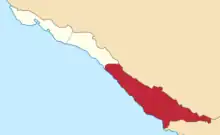Sochinsky okrug
Сочинскій окргъ | |
|---|---|
 Coat of arms | |
 Location in the Black Sea Governorate | |
| Country | Russian Empire |
| Viceroyalty | Caucasus |
| Governorate | Black Sea |
| Established | 1849 |
| Abolished | 1917 |
| Capital | Sochi |
| Area | |
| • Total | 3,761.11 km2 (1,452.17 sq mi) |
| Population (1916) | |
| • Total | 62,920 |
| • Density | 17/km2 (43/sq mi) |
| • Urban | 21.06% |
| • Rural | 78.94% |
The Sochinsky okrug[lower-alpha 1] was a district (okrug) of the Black Sea Governorate of the Caucasus Viceroyalty of the Russian Empire. It bordered the Kuban Oblast to the north, the Tuapsinsky okrug to the west, the Sukhumi okrug to the east, and the Black Sea to the south. The area of the Sochinsky okrug mostly corresponds to the Krasnodar Krai region of the Russian Federation. The district was eponymously named for its administrative centre, Sochi.[1]
Demographics
Russian Empire Census
According to the Russian Empire Census, the Sochinsky okrug had a population of 13,519 on 28 January [O.S. 15 January] 1897, including 8,147 men and 5,372 women. The plurality of the population indicated Armenian to be their mother tongue, with significant Russian, Greek, Ukrainian, Circassian, and Georgian speaking minorities.[2]
| Language | Native speakers | % |
|---|---|---|
| Armenian | 3,857 | 28.53 |
| Russian | 2,561 | 18.94 |
| Greek | 2,092 | 15.47 |
| Ukrainian | 1,240 | 9.17 |
| Circassian | 746 | 5.52 |
| Georgian | 681 | 5.04 |
| Romanian | 613 | 4.53 |
| Estonian | 599 | 4.43 |
| Turkish | 332 | 2.46 |
| Mingrelian | 269 | 1.99 |
| German | 166 | 1.23 |
| Persian | 59 | 0.44 |
| Belarusian | 53 | 0.39 |
| Imeretian | 52 | 0.38 |
| Polish | 49 | 0.36 |
| Tatar[lower-alpha 2] | 28 | 0.21 |
| Jewish | 13 | 0.10 |
| Czech | 12 | 0.09 |
| Other | 97 | 0.72 |
| TOTAL | 13,519 | 100.00 |
Kavkazskiy kalendar
According to the 1917 publication of Kavkazskiy kalendar, the Sochinsky okrug had a population of 62,920 on 14 January [O.S. 1 January] 1916, including 37,516 men and 25,404 women, 16,227 of whom were the permanent population, and 46,693 were temporary residents:[5]
| Nationality | Urban | Rural | TOTAL | |||
|---|---|---|---|---|---|---|
| Number | % | Number | % | Number | % | |
| Russians | 9,653 | 72.83 | 22,170 | 44.64 | 31,823 | 50.58 |
| Armenians | 521 | 3.93 | 13,590 | 27.36 | 14,111 | 22.43 |
| Other Europeans | 1,003 | 7.57 | 8,324 | 16.76 | 9,327 | 14.82 |
| Georgians | 1,750 | 13.20 | 4,336 | 8.73 | 6,086 | 9.67 |
| North Caucasians | 22 | 0.17 | 732 | 1.47 | 754 | 1.20 |
| Shia Muslims[lower-alpha 3] | 227 | 1.71 | 453 | 0.91 | 680 | 1.08 |
| Jews | 73 | 0.55 | 0 | 0.00 | 73 | 0.12 |
| Sunni Muslims[lower-alpha 4] | 5 | 0.04 | 49 | 0.10 | 54 | 0.09 |
| Roma | 0 | 0.00 | 12 | 0.02 | 12 | 0.02 |
| TOTAL | 13,254 | 100.00 | 49,666 | 100.00 | 62,920 | 100.00 |
Notes
- ↑
- ↑ Before 1918, Azerbaijanis were generally known as "Tatars". This term, employed by the Russians, referred to Turkic-speaking Muslims of the South Caucasus. After 1918, with the establishment of the Azerbaijan Democratic Republic and "especially during the Soviet era", the Tatar group identified itself as "Azerbaijani".[3][4]
- ↑ Primarily Tatars.[6]
- ↑ Primarily Turco-Tatars.[6]
References
- ↑ Tsutsiev 2014.
- ↑ "Демоскоп Weekly - Приложение. Справочник статистических показателей". www.demoscope.ru. Retrieved 2022-05-08.
- ↑ Bournoutian 2018, p. 35 (note 25).
- ↑ Tsutsiev 2014, p. 50.
- ↑ Кавказский календарь на 1917 год, pp. 214–217.
- 1 2 Hovannisian 1971, p. 67.
Bibliography
- Bournoutian, George A. (2018). Armenia and Imperial Decline: The Yerevan Province, 1900–1914. Milton Park, Abingdon, Oxon: Routledge. ISBN 978-1-351-06260-2. OCLC 1037283914.
- Hovannisian, Richard G. (1971). The Republic of Armenia: The First Year, 1918–1919. Vol. 1. Berkeley: University of California Press. ISBN 978-0520019843.
- Кавказский календарь на 1917 год [Caucasian calendar for 1917] (in Russian) (72nd ed.). Tiflis: Tipografiya kantselyarii Ye.I.V. na Kavkaze, kazenny dom. 1917. Archived from the original on 4 November 2021.
- Tsutsiev, Arthur (2014). Atlas of the Ethno-Political History of the Caucasus (PDF). Translated by Nora Seligman Favorov. New Haven: Yale University Press. ISBN 9780300153088. Archived (PDF) from the original on 17 June 2023.